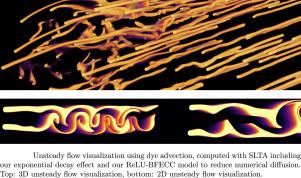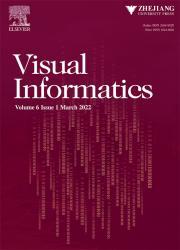Dye advection without the blur: ML-based flow visualization
IF 3.8
3区 计算机科学
Q2 COMPUTER SCIENCE, INFORMATION SYSTEMS
引用次数: 0
Abstract
Semi-Lagrangian texture advection (SLTA) enables efficient visualization of 2D and 3D unsteady flow. The major drawback of SLTA-based visualizations is numerical diffusion caused by iterative texture interpolation. We focus on reducing numerical diffusion in techniques that use textures sparsely populated by solid blobs, such as typically in dye advection. A ReLU-based model architecture is the foundation of our ML-based approach. Multiple model configurations are trained to learn a performant interpolation model that reduces numerical diffusion. Our evaluation investigates the models’ ability to generalize concerning the flow and length of the advection process. The model with the best tradeoff between the computational effort to compute, quality of the result, and generality of application is found to be single-layer ReLU-based. This model is further analyzed and explained in-depth and improved using symmetry constraints. Additionally, a metamodel is fitted to predict single-layer ReLU model parameters for advection processes of any length. The metamodel removes the need for any prior training when applying our technique to a new scenario. Additionally, we show that our model is compatible with Back and Forth Error Compensation and Correction to improve the quality of the advection result further. We demonstrate that our model shows excellent diffusion reduction properties in typical examples of 3D steady and unsteady flow visualization. Finally, we utilize the strong diffusion reduction capabilities of our model to compute dye advection with exponential decay, a novel method that we introduce to visualize the extent and evolution of unsteadiness in both 2D and 3D unsteady flow.

没有模糊的染料平流:基于ml的流动可视化
半拉格朗日纹理平流(SLTA)可以实现二维和三维非定常流场的高效可视化。基于slta的可视化的主要缺点是由迭代纹理插值引起的数值扩散。我们专注于在使用由固体斑点稀疏填充的纹理的技术中减少数值扩散,例如通常在染料平流中。基于relu的模型架构是我们基于ml的方法的基础。训练多个模型配置以学习减少数值扩散的高性能插值模型。我们的评估考察了模型对平流过程的流量和长度的概括能力。在计算工作量、结果质量和应用程序的通用性之间取得最佳平衡的模型是基于单层relu的模型。对该模型进行了深入的分析和解释,并利用对称约束对其进行了改进。此外,还拟合了一个元模型来预测任意长度的平流过程的单层ReLU模型参数。在将我们的技术应用于新场景时,元模型消除了任何预先培训的需要。此外,我们还证明了该模型兼容前后误差补偿和校正,以进一步提高平流结果的质量。在三维定常和非定常流动显示的典型实例中,我们证明了该模型具有良好的扩散还原性能。最后,我们利用该模型强大的扩散还原能力来计算具有指数衰减的染料平流,这是一种新颖的方法,我们引入该方法来可视化二维和三维非定常流中的非定常程度和演变。
本文章由计算机程序翻译,如有差异,请以英文原文为准。
求助全文
约1分钟内获得全文
求助全文
来源期刊

Visual Informatics
Computer Science-Computer Graphics and Computer-Aided Design
CiteScore
6.70
自引率
3.30%
发文量
33
审稿时长
79 days
 求助内容:
求助内容: 应助结果提醒方式:
应助结果提醒方式:


